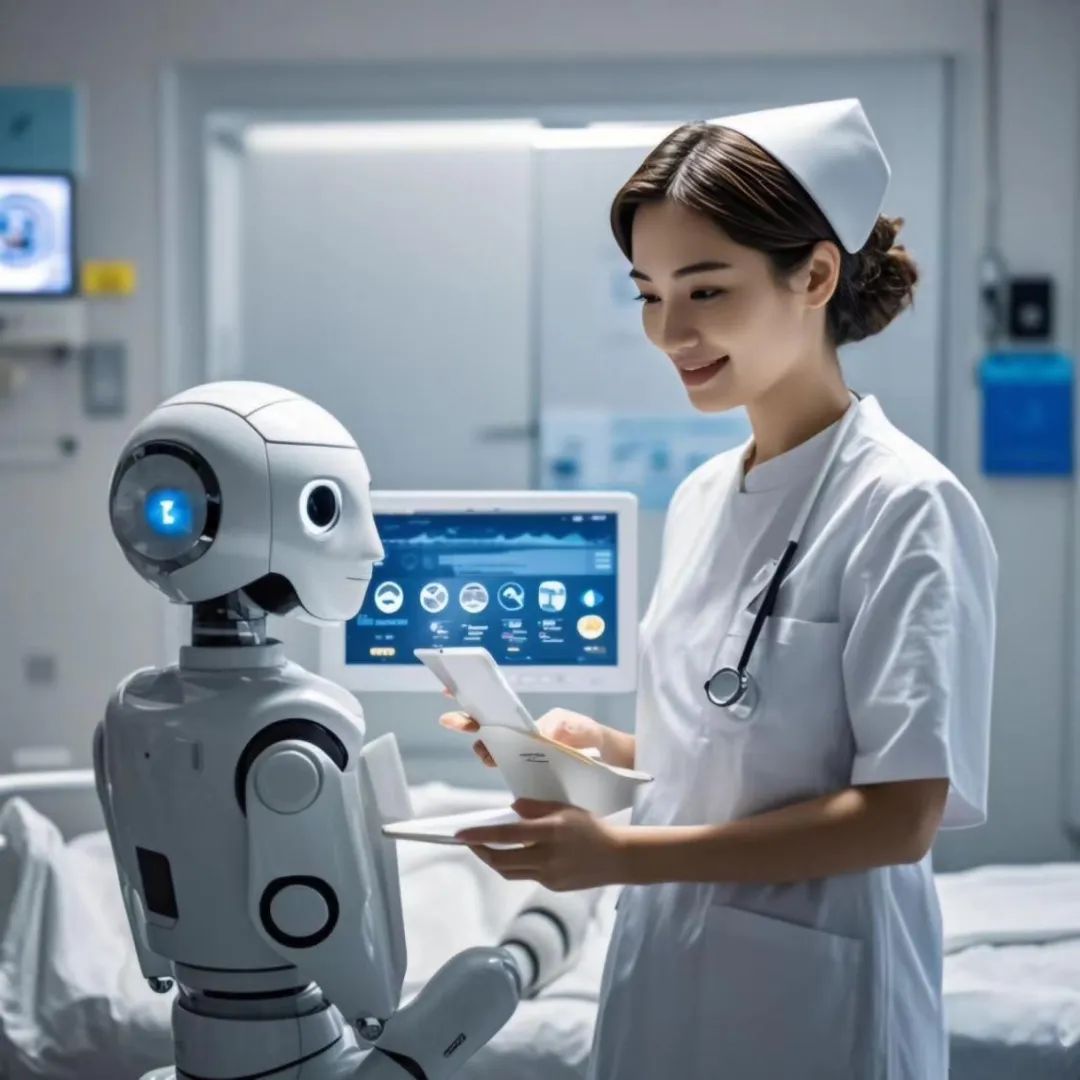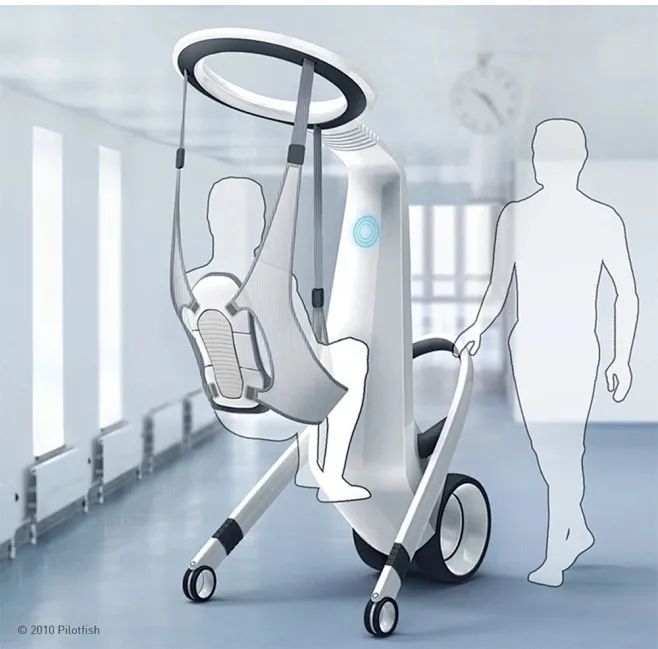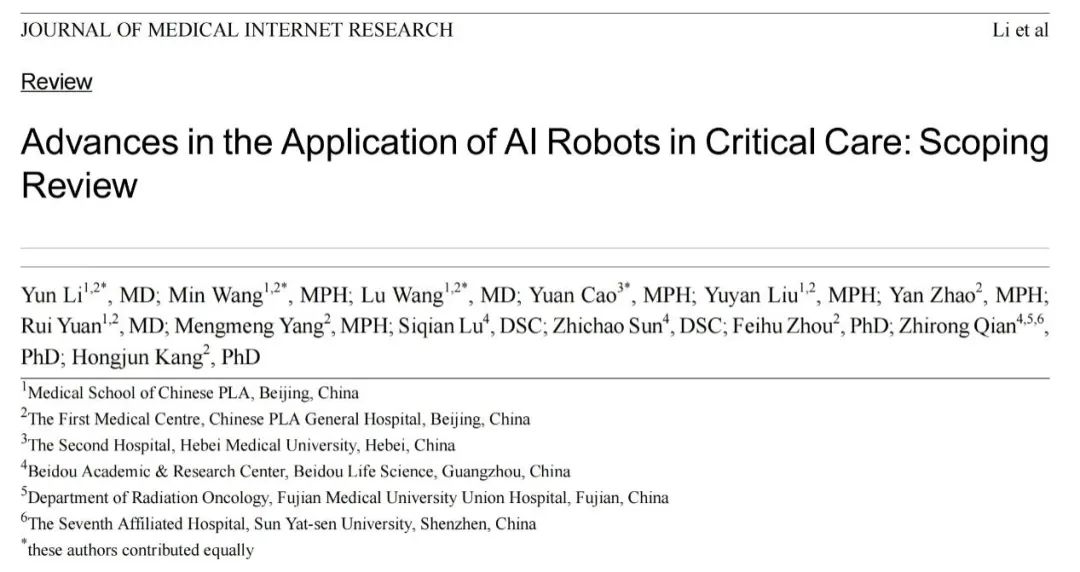

1. Background
● In recent years, with the integration of Artificial Intelligence (AI), significant advancements have been made in the field of critical care medicine. Specifically, AI robots have evolved from theoretical concepts to practical applications and are actively involved in clinical trials. The Intensive Care Unit (ICU), with its reliance on vast amounts of medical information, has become a promising area for the deployment of robotic AI, expected to bring significant improvements to patient care.
● The COVID-19 pandemic in 2020 accelerated the application and transformation of “Healthcare + AI + Robotics” technologies.

2. Purpose
● To comprehensively summarize the current state of AI robots in the field of critical care, including related research, developments, applications, and ethical challenges faced.

3. Methodology
● Followed the framework for scoping reviews proposed by Arksey and O’Malley and the PRISMA-ScR guidelines for literature retrieval and analysis.
● Retrieved articles from three databases: PubMed, Embase, and IEEE Xplore Digital Library, ultimately including 77 articles covering 21 ICU robot projects.

4. Results
● Application Overview: Based on application scenarios and functions, AI robots in the ICU can be categorized into five types: therapeutic assistance robots, nursing assistance robots, rehabilitation assistance robots, remote presence robots, and logistics and disinfection robots.

● Specific Situations of Each Type of Robot:
4.1. Therapeutic Assistance Robots:
-
Ventilator Installation Cartesian Robot: Can remotely control and monitor ventilators, reducing the time healthcare personnel spend entering the ICU and lowering infection risks, but faces challenges in cleaning and disinfection.
-
McSleepy: A robot used for anesthesia that can autonomously control anesthesia, analgesia, and neuromuscular blockade, improving the efficiency of anesthesiologists and ensuring the safety of anesthesia.
-
Cardiopulmonary Resuscitation Robot: Capable of performing high-quality cardiopulmonary resuscitation, improving the success rate of cardiac resuscitation, and reducing labor costs.

4.2. Nursing Assistance Robots:
-
Venous Puncture Robot: Such as VenousPro and 9-df image-guided venous puncture robots, can automatically identify suitable blood vessels for safe blood sampling, reducing the risk of needle stick injuries and potentially integrating with diagnostics.
-
Suction Robot: For example, developed by Xi’an Jiaotong University, can stably perform suction operations but faces challenges like complex robotic arm structures and limited mobility.
-
Kangaroo Care Robot Calmer: Used to simulate kangaroo care for premature infants, effectively managing acute pain in premature infants, saving nursing time and costs, but cannot replace parental or neonatal care.
-
Paro: A nursing robot providing social and emotional support for elderly patients, but currently lacks evidence that it can improve cognition immediately or in the long term.
4.3. Rehabilitation Assistance Robots:
-
Lokomat: A robotic system for gait rehabilitation that can improve patients’ muscle strength, physical and mental independence, and walking distance through assisted training, widely used in rehabilitation therapy, but its application in the ICU is still limited.
-
ArmeoSpring: A passive exoskeleton robot for upper limb rehabilitation that can serve as a tool for assessing upper limb capability and range, but its effectiveness in improving upper limb function is still unclear.
-
KINARM: A robotic research tool for assessing sensory motor, proprioceptive, and cognitive brain function in ICU patients, providing objective and quantifiable data, but has limitations that require further improvement.

4.4. Remote Presence Robots:
-
InTouch Health Remote Presence – 7 (RP – 7): A real-time audiovisual remote presence robot system that can be used for patient assessment, improving ICU efficiency, but shows no significant improvement in collaboration between nurses and doctors.
-
Stevie: Equipped with a stethoscope port and HD camera, helps doctors identify diseases, designed to be user-friendly and easily accepted.
-
MGI Ultrasound System – Remote 3 (MGIUS – R3): A robot-assisted remote ultrasound diagnostic system with broad application value in the ICU, capable of remote ultrasound examinations, reducing infection risks, but relies on a stable 5G network.
-
5G + Medical Robots + VR Visiting System: Allows family members to visit remotely, enhancing the humanization of medical services, but requires high-speed, low-latency 5G network support.
4.5. Logistics and Disinfection Robots:
-
HelpMate (Transport Robot): Can autonomously transport supplies and patients, improving ICU efficiency and avoiding cross-infection, has been in use since the 1980s.
-
Infection Control Robots: Such as the Xenex robot (using pulsed xenon to produce broad-spectrum UV disinfection) and “EPS” logistics disinfection robot (with transportation and disinfection functions), as well as a hydrogen peroxide vapor disinfection robot jointly developed by Shanghai Jiao Tong University and Lingzhi Technology (capable of autonomous navigation and disinfection), making ICU wards safer and cleaner.

5. Challenges and Potential Solutions:
5.1. Safety Issues: The lack of clear safety and accuracy standards and assessment procedures, as well as biases in AI algorithms, necessitate consideration of the socio-technical context. Measures have been taken by various countries to address these issues, such as the establishment of AI foundation model working groups in the UK, updates to the AI white paper by the Chinese Association for Artificial Intelligence, and the signing of the “Bletchley Declaration” by 28 countries.
5.2. Dignity Issues: Patients in the ICU require humanistic care and emotional support, which AI robots lack. Incorporating emotional recognition technology can provide corresponding support, but currently, the AI safety field lacks diversity in thought and demographics, potentially leading to biases based on race, gender, etc., necessitating expanded participation to avoid product defects.
5.3. Privacy Issues: The collection of patient data by robots may infringe on privacy, requiring compliance with privacy regulations, such as the General Data Protection Regulation in Europe, using encryption technology, controlling data acquisition scope, ensuring anonymization, and establishing strict access control mechanisms and ethical guidelines.
5.4. Liability Issues: Granting robots autonomy and decision-making capabilities complicates liability attribution. When failures occur, it becomes challenging to determine responsibility. A legal framework related to AI robots needs to be established to clarify the responsibilities of manufacturers, operators, and users, with regulatory bodies also playing a role. The US and EU advocate for algorithm transparency and accountability, while the UK has introduced the “Data-Driven Health and Care Technology Code of Conduct” and a “Regulatory as a Service” model. The US Government Accountability Office has released an AI accountability framework.
5.5. Cost-Effectiveness Issues: The research and application costs of AI robots are high, but from a utility perspective, they can meet medical needs and reduce disparities in healthcare in resource-scarce countries like China, possessing significant social value.

6. Discussion
● Major Findings: AI robots hold significant importance in critical care, currently in the initial stages with considerable room for development and challenges. Experts believe that AI will not completely replace doctors but will assist them in improving efficiency.
● Limitations: There may be publication bias and subjective bias, and there is a lack of a unified classification system for ICU robots.

7. Conclusion
This review comprehensively covers AI robots in the ICU, indicating that while there are ethical and safety issues, future policies and regulations should be developed to address these problems, making AI robots an essential part of the ICU and other hospital wards.

Source: Zhongwei Nursing Research Institute
Recommended Reading
Library: Premium library exclusive to nurses
Video Channel: Nursing insights and expert live streams
Book Purchase: Nursing books, all the books nurses need
Question Bank: New guidelines, new consensus, new standard practice questions
Follow: WeChat public account categorized by nursing departments
Click the “Read Original” below to download the Zhihu app